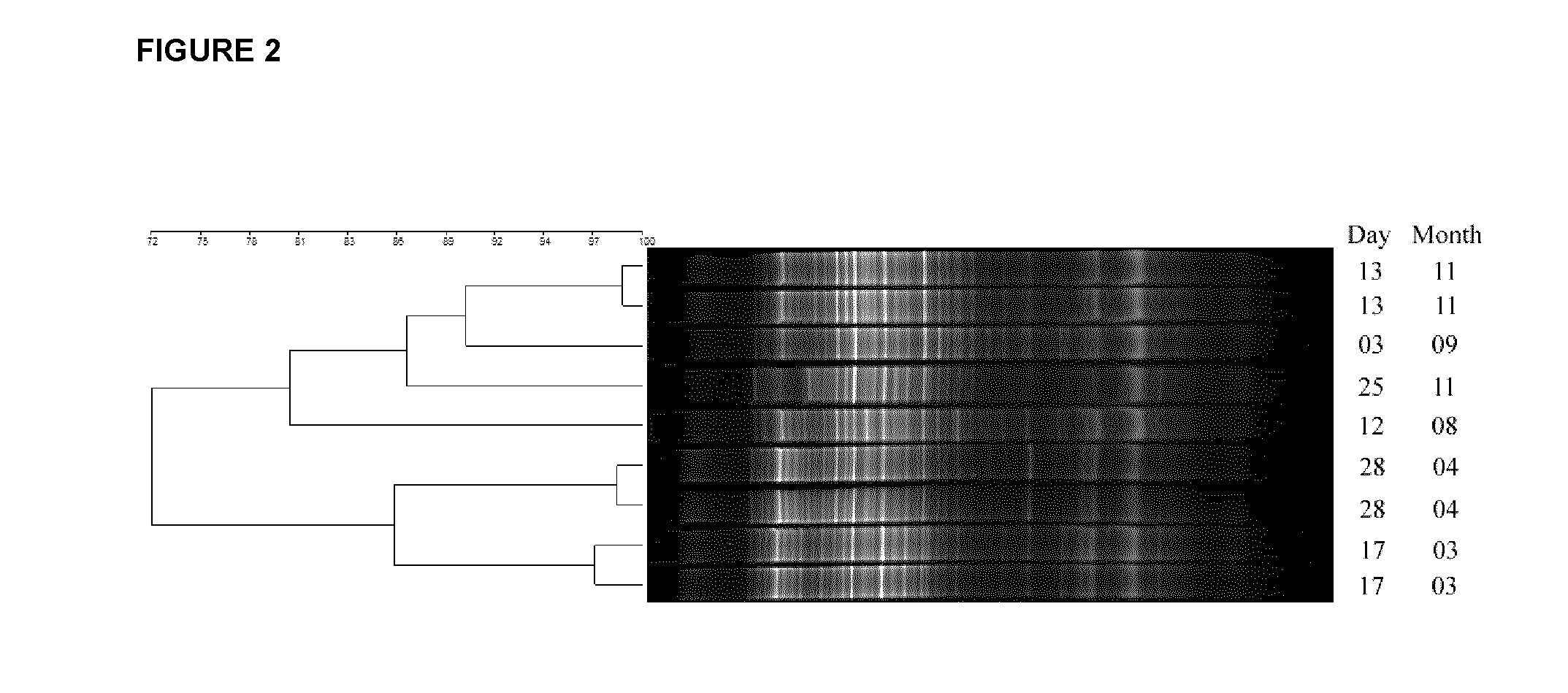Media supplements and methods to culture human gastrointestinal anaerobic microorganisms
a technology of anaerobic microorganisms and media supplements, which is applied in the field of media supplements and methods to culture human gastrointestinal anaerobic microorganisms, can solve the problems of difficult culture of gut microorganisms, hampered studies of gut microorganisms, and novel culture techniques to grow these microorganisms. to achieve the effect of enhancing the growth of axenic bacteria in vitro
- Summary
- Abstract
- Description
- Claims
- Application Information
AI Technical Summary
Benefits of technology
Problems solved by technology
Method used
Image
Examples
example 1
Threshold for DGGE Analysis
[0125]A study by Possemiers et al. (Possemiers, S. et al., FEMS Microbiol. Ecol., 49(3):495-507, 2004) established a threshold stability criterion of 80% similarity (or 20% variability) for DGGE studies based on within-gel variability seen between identical marker lanes. According to this study, the threshold can be used in conjunction with moving window correlation analysis to monitor the dynamics of the community. This approach allows us to examine the similarity of a vessel to itself over time. The 80% similarity threshold can then be used to determine how long it takes a vessel to rise above this cut-off and reach steady state.
[0126]In order to apply this threshold to our studies, a similar analysis was carried out on the marker lanes from our DGGE gels. We found an average of 80.4±8.9% similarity, or 19.6±8.9% variability, between these marker lanes. Since these values correspond well with the values used in the Possemiers et al. study, a threshold of...
example 2
Comparison of Same Donor Over Time
[0128]The DGGE pattern of 10% inocula from Donor 2 (a 38-year old healthy female) over an 8 month period is shown in FIG. 2. As seen by visual inspection, the variation in the profiles seems to be due to differences in band brightness, not the appearance or disappearance of bands. The inocula isolated from this donor had an average correlation coefficient of 76.9±8.7%. Slight differences between profiles were shown in FIG. 2 where samples showed slightly higher similarity depending on the time of sample collection. Overall, the gut microbiota of this healthy donor remained stable over time.
[0129]The gut microbiota of this donor maintained a high diversity over time, with an average Shannon-Weaver index value of 3.39±0.08. The donor's microbiota also maintained a very high average range-weighted richness at 776.5±27.7. Finally, the community evenness was stable over time, with an average Shannon equitability value of 0.82±0.02.
example 3
Comparison of Different Donors
[0130]We used DGGE to compare fecal inocula isolated from four different healthy donors (from 38 to 43 years of age with no recent history of antibiotic treatment) (FIG. 3). We found that the fecal community of each donor was different from the communities of other individuals (as expected, Tannock, G. W., Eur. J. Clin. Nutr., 56 Suppl. 4:S44-9, 2002). The average correlation coefficient between the inocula from different donors was 74.4±8.4%.
[0131]The gut microbiota of all four donors had high diversity, with an average Shannon-Weaver index value of 3.42±0.04. The donor microbiota also maintained a very high average range-weighted richness at 585.3±26.2. The community evenness between the different donors was quite similar, with an average Shannon equitability value of 0.86±0.01.
[0132]We also used DGGE to compare two different communities, seeded by fecal samples from two different healthy donors, each of whom donated on at least two separate occasions...
PUM
 Login to View More
Login to View More Abstract
Description
Claims
Application Information
 Login to View More
Login to View More - R&D
- Intellectual Property
- Life Sciences
- Materials
- Tech Scout
- Unparalleled Data Quality
- Higher Quality Content
- 60% Fewer Hallucinations
Browse by: Latest US Patents, China's latest patents, Technical Efficacy Thesaurus, Application Domain, Technology Topic, Popular Technical Reports.
© 2025 PatSnap. All rights reserved.Legal|Privacy policy|Modern Slavery Act Transparency Statement|Sitemap|About US| Contact US: help@patsnap.com



